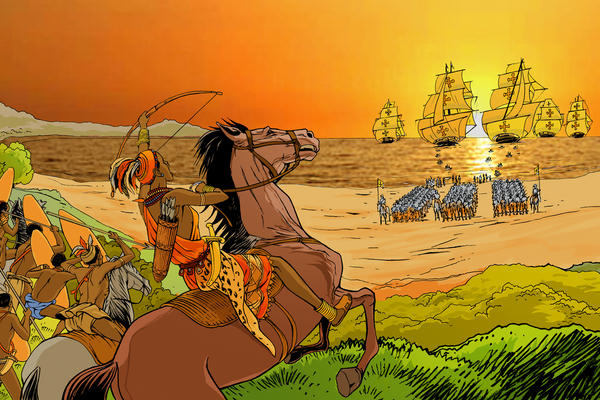The Country That Dare Not Speak Its Name
photograph by Darmon Richter
In the heart of Europe’s Balkan Mountains, there exists a tense naming dispute between nations, a 20-year political battle, which has its roots in a 2,800-year history. We’re talking about Macedonia – the small Eastern European country bordered by Bulgaria to the east, Greece to the south, Albania in the west, and to the north, both Serbia and Kosovo. Well, just Serbia in the north, if you’re from Spain, Greece, China, Brazil, or one of the 80 or so other countries that refuse to accept Kosovo’s independence.
In terms of borders and politics, it might be fair to say that the Balkans are a mess.
The Ottoman Empire laid claim to these lands for centuries, and only once they were finally vanquished were the local populations able to piece back together their former cultures and identities, a process which escalated into fierce border debates around the time of the First and Second Balkan Wars.
The First World War kicked off here in the Balkans too, with the assassination of Austria’s Archduke Franz Ferdinand in Sarajevo, Bosnia. When the dust settled in 1918, these lands were united as Yugoslavia, only to be sent into chaos once more in 1941, as Yugoslavia fell under the full force of Hitler’s blitzkrieg.
There are approximately 40,000 muslims in modern-day Macedonia, Islam having arrived by way of the Ottomans (photograph by Darmon Richter)
Orthodox Christianity remains the dominant faith however, with more than two million followers (photograph by Darmon Richter)
In 1945, Josip Broz Tito would reunite the Balkans once again. Partisan forces overthrew their fascist masters in the course of a bloody civil war, following which Yugoslavia would rise again, this time under a red flag, as the Socialist Federal Republic of Yugoslavia. Tito famously pitted Yugoslavia’s nation-states against their neighbors, so that by the time Yugoslavia faced its eventual dissolution in the 1990s, the process was marked by a series of messy splits, land grabs, and wars, which between them would dominate the news for most of a decade.
The Republic of Macedonia declared its independence from Yugoslavia in 1991, and in 1993 it became a member of the United Nations, though not without complications. The problem was, there was already a Macedonia in the UN — the Greek region of Macedonia — and at Greece’s behest this new republic was only permitted to enter the United Nations under the provisional title of fYROM, or “former Yugoslav Republic of Macedonia.”
Hydrometeorological building in Skopje (photograph by Darmon Richter)
More Yugoslav-brutalist architecture in Skopje, this time, the post office (photograph by Darmon Richter)
A Macedonian flag flies from Skopje’s Television Center (photograph by Darmon Richter)
The contemporary Greek position is this: Macedonia, as they perceive it, is a Greek territory and a name that is integral to Greek history and heritage. They don’t want to share Greek history with their Slavic neighbors in the north, but moreover, Athens fears that the Republic of Macedonia, so-named, would stand a better chance of stealing territories from the region of Greek Macedonia.
In addition to calling for the provisional “former Yugoslav Republic of” prefix in relation to Macedonia’s UN membership (which was declared a temporary solution at the time, but remains unresolved 15 years later), Athens has successfully blocked its neighbor from gaining membership to either NATO or the EU, until such a time that the dispute reaches a satisfactory conclusion.
Several solutions have been suggested to the problem: names such as “Northern Macedonia,” or “Republika Makedonija-Skopje” (the latter having been suggested in 2005, but rejected almost immediately by the government in Skopje). Greece won’t stand for the idea of different names being used in different countries, either — but rather, they desire a solution that is universally adopted.
Kale Fortress in Skopje, a former Byzantine stronghold (photograph by Darmon Richter)
A contemporary water fountain in the heavily redeveloped center of Skopje (photograph by Darmon Richter)
The spat between Greece and the (RO / fYRO) Macedonia is as complex as it is heated, and in order to better understand the historical background to the debate, there are three Macedonias that one need consider: the (former Yugoslav) Republic of Macedonia, the Greek region of Macedonia, and the ancient Macedon Kingdom.
Histories place the foundation of the Macedon Kingdom at some time around the 7th or 8th century BC. For a brief period, it rose to become the world’s most powerful state, most notably under the leadership of King Alexander III of Macedon — known commonly as Alexander the Great.
Geographically, that ancient kingdom now lays spread over the borders of Greek Macedonia and the Republic of Macedonia. As a result, both Skopje and Athens have an inclination to lay claim to the spoils of Macedon heritage, a debate which grows particularly heated in the case of Alexander himself, who is by turns described as Greek or Macedonian depending on who you ask (or rather, more precisely, as Macedonian or Greek-Macedonian).
In Nestos, Greek Macedonia, there stands an airport named after Alexander the Great. When in 2006 the Republic of Macedonia announced plans to dedicate Skopje Airport likewise to Alexander, it threw more fuel on an already roaring fire. Things only grew worse in 2011, when a 22-meter statue appeared in the heart of Skopje’s Macedonia Square depicting an unnamed warrior king on horseback. Skopje has never given the statue an official name, but Athens took the hint all the same.
Macedonia Square, featuring the unnamed warrior king on horseback (photograph by Darmon Richter)
Disclaimer: Any resemblance to real persons, living or dead (and in particular, to Alexander the Great), is purely coincidental. (photograph by Darmon Richter)
Today the diplomatic struggle rages on. In Skopje, and the Republic of Macedonia as a whole, the people are proud of their history and of the name that unites them. Even if their government were to attempt an identity shift to appease Greece, polls consistently demonstrate that such a move would be met with widespread resistance.
Across the border to the south, many Greeks argue that the version of history taught in (RO / fYRO) Macedonia is a lie, that the history books which link them to ancient Macedon, to Alexander the Great, were largely fabricated by Tito’s propaganda machine — an effort to bolster national pride and, ultimately, to legitimize Yugoslavia’s grab for Northern Greece. According to the Greeks, these northern neighbors are Slavs, late arrivals in an ancient land, who hold no claim to local history.
The Ilinden Spomenik: A Yugoslav-era monument in Macedonia, celebrating a 1903 uprising against Ottoman rule (photograph by Darmon Richter)
The Ilinden Spomenik in Krusevo, nicknamed the ‘Makedonium’ (photograph by Darmon Richter)
Reliefs inside the Makedonium tell the story of Macedonia’s struggle for independence (photograph by Darmon Richter)
Skopje, on the other hand, would urge Greece to relax its position. History is not static, they say, and just because Greece hasn’t achieved much of note in the last few thousand years, it doesn’t mean the world has stopped turning. Macedon was indeed a Greek state 2,500 years ago, but since then the region, and name, have been appropriated to define a Roman province, an Ottoman province, and later a republic of Yugoslavia. The Macedonian people — Slavic or not — have evolved with that name, and Macedonia’s history is their history. It is not the place of one country to dictate how another defines their identity; definitions which held true 2,500 years ago should not be used as a basis to enforce contemporary politics.
Ask a Macedonian (to clarify: a resident of RO / fYRO Macedonia), and they’ll tell you that they have no desires on Greek land — the government in Skopje has even signed formal agreements promising to make no claims on Greek Macedonia. They simply want to be permitted to celebrate their own identity, one that dates back to the 680 AD conquest of this region by Slavic tribes. No, perhaps they’re not native to these lands, but the Macedon Kingdom had already fallen to Roman rule long before the Slavs arrived. For Greece to claim the sole right to Macedon heritage, therefore, is to ignore an awful lot that has happened since.
Nevertheless, nationalism is strong in the Balkans — where a bloody history of upheaval and conquest lends itself to sensitivity over precariously defined identities. In the case of the Macedonian naming dispute, there would appear to be no truce in sight, and so for the time being at least, the Republic of Macedonia maintains the dubious position of a country that dare not speak its name.
The town of Ohrid in southern Macedonia was a former capital of the Bulgarian Empire (photograph by Darmon Richter)
Sunset over Lake Ohrid (photograph by Darmon Richter)
The Church of Saint Panteleimon, Ohrid, Macedonia (photograph by Darmon Richter)
Darmon Richter is a freelance writer, photographer, and urban explorer. You can follow his adventures at The Bohemian Blog, or for regular updates, follow The Bohemian Blog on Facebook.















Follow us on Twitter to get the latest on the world's hidden wonders.
Like us on Facebook to get the latest on the world's hidden wonders.
Follow us on Twitter Like us on Facebook